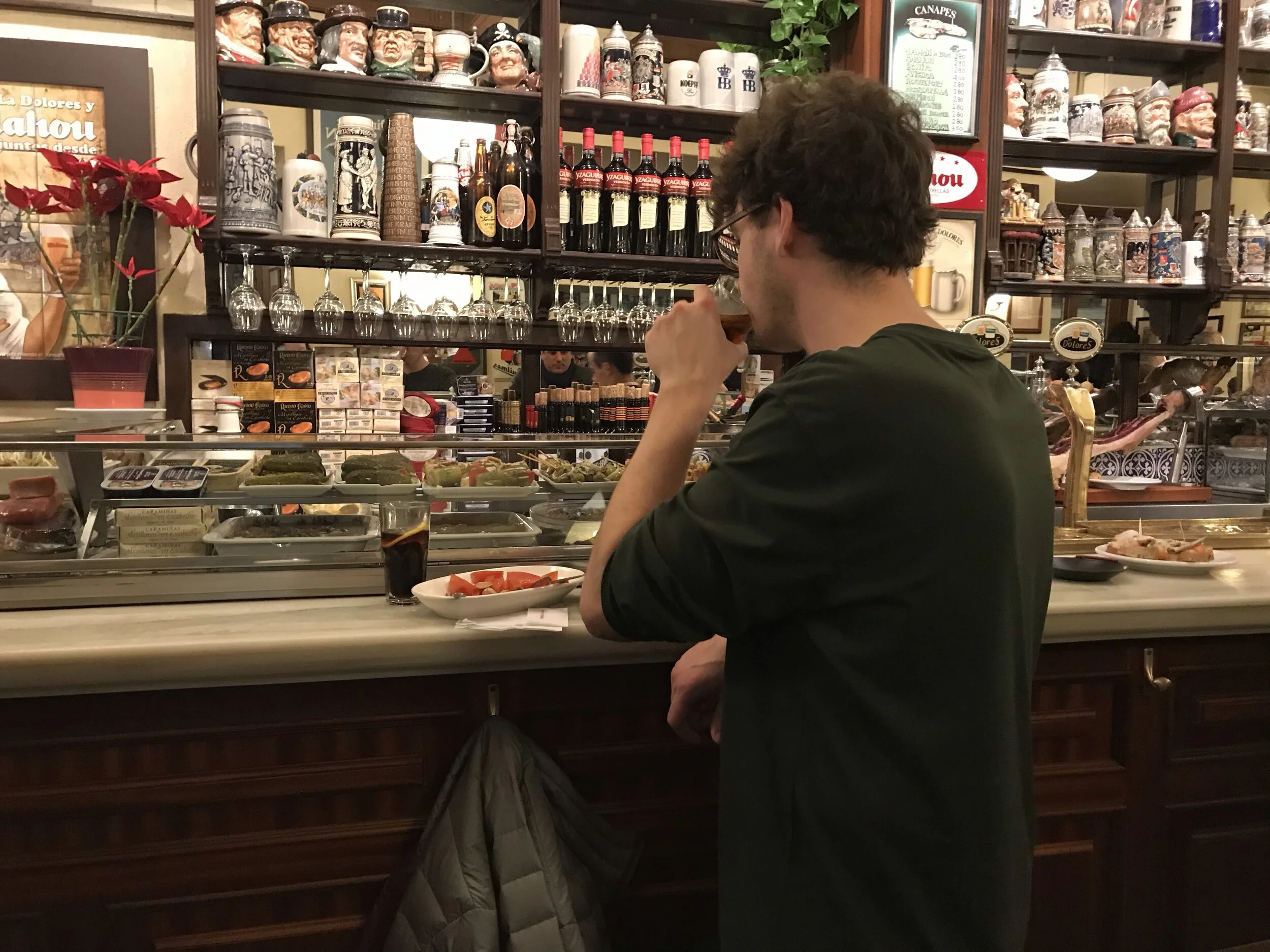A Tour of Tapas: Taberna la Dolores & Tuna Mojama
I wrote a few days ago about tapas in Spain and about how they uniquely reflect not only Spanish food but Spanish culture more broadly. Tapas aren’t, as we’ve come to understand them in the US, about going out for a meal comprised of small plates. Rather, they’re about going out to catch up with family and friends, and finding yourself accidentally full after a few hours of lively conversation, drinks, and one toothpick after the other of irresistible bites.
And we’ve certainly had our fill. Over a series of upcoming posts, I’ll be sharing some of our favorite tapas experiences so far from around the country. ¡Buen provecho!
Taberna La Dolores, Madrid
Two small plates land on the marble bar in front of us before we’ve even ordered. Before we’ve taken our coats off, actually. One, fat slices of Chorizo de Ibérico, slicking the plate red with oil. The other, glistening green olives studded with anchovy, every light of the narrow bar reflected in their skins like a pile of savory disco balls. We’re hungry (it’s nine, time for a pre-dinner bite here in Spain) but we need drinks first - beer, vermouth, sangria - to cut through the salt and fat.
I catch my reflection in the gilded mirror behind the bar, peering back at me from between dusty steins lining the shelves. We’re a stones throw from El Prado at Taberna La Dolores which has been serving beer and tapas since the ’20's. Busy waiters with slicked hair, black vests, and ties deliver tapas and drinks from behind glass cases which run the length of the bar. Like terrariums, these cases each contain trays filled with all manner of creatures swimming in brines or reclined across slices of baguette. Others are filled with pyramids of skewers six high, little identical soldiers with red pepper coats and anchovy faces. These are pinchos, a style of tapa which is always served on a stick, logically or not (i.e. at some other places – usually those without gilded mirrors, a copper ceiling, and bow-tied staff – small, slider-like sandwiches and even whole fishes arrive like St. Sebastian, studded with wood). But here, the meticulously arranged pinchos are all perfectly contrived; each designed to pair with one of the half-dozen drinks available on the limited menu: caramely Amontillado…
…is accompanied by a salty fresh goat’s cheese swaddled in jamón serrano, boquerones en vinagre (vinegar marinated anchovies) lighten a robust red wine while their partners, boquerones en aceite (in olive oil), get a mineral-rich and acidic white, and so on, one perfectly paired bite after the other encouraging a palette whetting drink to continue the cycle.
Our drinks plus pinchos arrive in the narrow strip of bar between the glass cases and the rail: a bit of Manchego and more chorizo with my beer and two more anchovy studded olives topped with an orange for Breezy’s vermouth. We’d have to be careful. It was still only our first week and we weren’t yet accustomed to the delirious thrill of Spanish tapas bars, where anyone can pretend to be rich, realizing very quickly the immense satisfaction of adding to a growing number of empty plates stacked in front of you. This was meant to be a tapas crawl, La Dolores only the first stop on our anally curated list of places and dishes to experience while in Madrid, and we’d already both eaten about 2 chorizos and a handful of olives (containing probably a tin of anchovies) with our first drink. Not ordinarily so much, but in this alternate universe where your food and drink order multiplies somewhere in the air between your lips and your waiter’s ear, a definite setback to a planned night of gorging.
Yes, we definitely have to be careful, I thought, as I ordered us two wines and their fishy counterparts, trying to buy some time with the hovering waiter. I was quickly scanning the menu for the dish we had come for, a specialty introduced by the Moors, and one which La Dolores is famous for. I could feel he was losing patience with the slow americano, and just as he began to turn away I lighted on and blurted out my order: “una tuna mojama, por favor!”…wind-cured tuna, “the ham of the sea.”
Within minutes the platter appeared, its shingled slices of tuna intensely maroon, appearing almost as a bruise across the white of the ceramic. Fat marcona almonds were plopped across its surface among intermittent hunks of too-firm tomatoes (we mistook them for underripe and out of season but have since found out it’s a peculiar Spanish variety which they say is intentionally firm but which we suspect is just a marketing ploy to get people to eat underripe and out of season tomatoes). And across everything, the sheen of olive oil, which revealed itself to be a grassy green where it pooled onto the platter at the tuna’s edges. Using only our fingers, we pushed the tomatoes aside and each…
…grabbed a sheet of tuna, wrapping it, like a piece of jamón, around a marcona. We popped these tidy packages into our mouths, immediately registering the fruity/peppery wallop of a very good olive. The tuna, though dried, was not dry, and had the texture of dehydrated mango, soft and giving with a residual sweetness from the tomato juices. As we chewed, the oil and Marcona spread, all fatty and rich, across our tongues, carrying with them the complex sweetness of the fish. It tasted uncannily like jamón
My concerns over our tapas schedule melted along with the tuna on my tongue. We didn’t have to worry, not really. The other stops could wait until tomorrow night. We went home, only stopping twice more along the way for “just one drink,” which invariably came with mounds of food. I think we’re starting to understand Spain.



